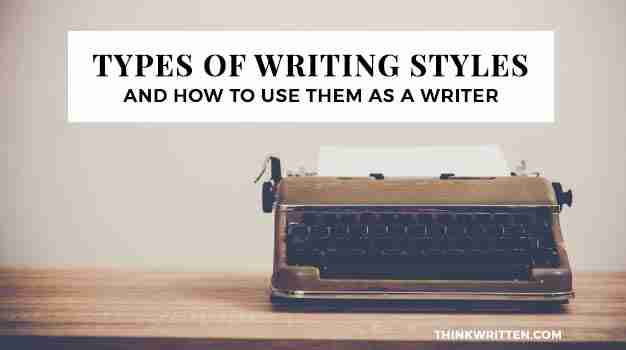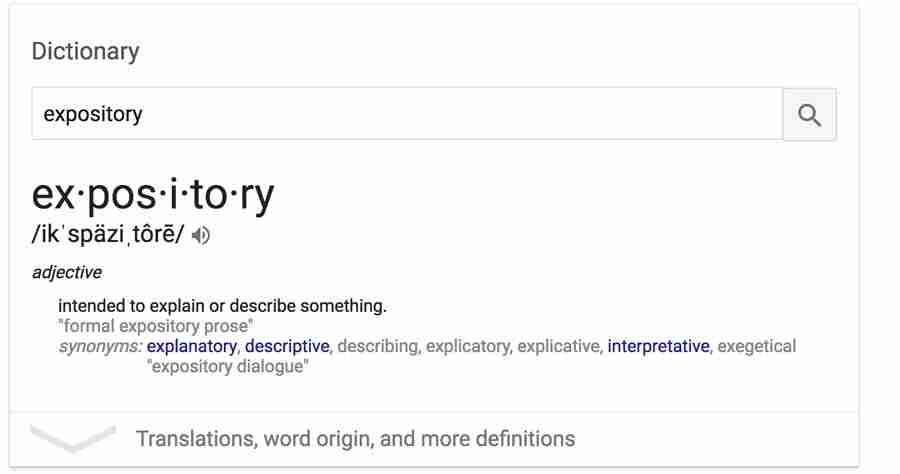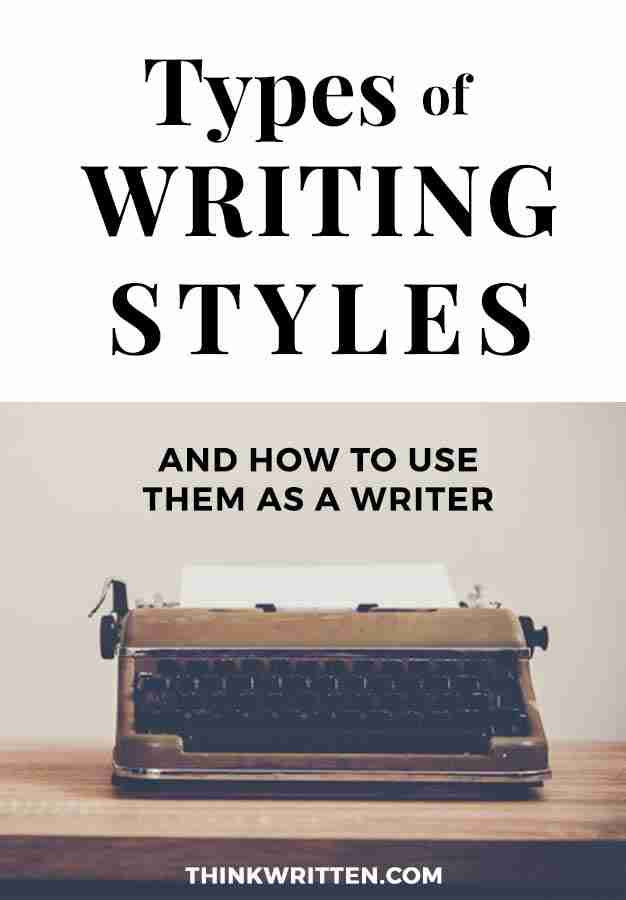We may receive a commission when you make a purchase from one of our links for products and services we recommend. As an Amazon Associate we earn from qualifying purchases. Thank you for support!
One of the things that can help you grow as a writer is to learn the 4 main types of writing styles and use the characteristics of each to further develop your own personal voice as a writer.

By learning how to use the different writing styles in your work, you will not only improve your skills as writer, but also learn ways to better connect with your audience of readers.
In this post we’ll cover the 4 main types of writing styles and how to use them as a writer to create compelling books, stories, essays, poetry, articles and more.
What are Writing Styles?
Writing styles are basically another way of saying the form or type of written work you are creating. Think of it as a classification for being able to identify what kind of writing you are creating.
For example, if you are writing a cookbook, that is a completely different style of writing than if you were writing a steamy romance novel!
Each writing style has a different purpose – and therefore, different characteristics are present when you are writing each type of different work.
Now that we understand what a writing style is – let’s talk about the 4 main writing styles which are commonly talked about amongst writers and literary educators.
The 4 Main Writing Styles & What They Mean
The four main writing styles which are commonly recognized are expository, descriptive, narrative, and persuasive.
Style #1: Expository

The definition of expository is this: “intended to explain or describe something.”
Most types of written work that fall into this category explain something in more detail, or provide insight and instruction in regards to a particular topic.
What types of writing fall into this category of expository writing style?
While there are many different types of written work which can be categorized as expository style of writing, you can often identify this type of writing by noticing the purpose of the work.
- Does the work intend to explain something in more detail?
- Does the written piece inform?
- Does the written piece answer questions such as “what, how and why?”

Here are some examples of the different types of writing pieces which can fall into the category of expository writing:
- Newspaper and Magazine Articles {not including editorials}
- Non-Fiction Books
- How-To Books
- Self Help Books
- Writing about Hobbies & Interests
- Recipes & Cookbooks
- Instructional Guides
- Scientific Research
- Manuals
- Textbooks & Educational Resources
- Business Articles & Books
- Medical Research, Journals and Articles
When you write expository style pieces, your main goal as a writer is to inform your readers with insight and facts that pertain to the subject of your piece.
For example, if you are writing about the history of ice cream, you would be including a lot of research and fun facts into your piece.
Note that this type of writing style is not intended to persuade or influence your audience. In writing your piece on the history of ice cream, you would NOT be trying to persuade your readers.
You would not want to say things like “Everybody should eat ice cream!” and “These 5 reasons will convince you forever to choose strawberry swirl flavored ice cream as your favorite flavor.”
Sometimes it can be confusing on whether an article is expository or persuasive. For example, an article called “The 5 Unexpected Health Benefits of Ice Cream” – would not fall into expository writing, even though it is providing information.
The word “benefits” has a positive connotation to the title. If you were to be writing an article on possible health benefits on ice cream, it would be very important that you as the writer keep your opinion separated from the facts and information if you plan for it to be an expository style piece. To be expository in nature, you would want to use a title such as “Scientists Research The Health Effects of Ice Cream.”
Books and articles that explain how to do something are also very popular examples of expository writing. Cookbooks are very popular, as they explain to others the tips, techniques, and recipes on how to cook something. How-to books for hobbies and crafts are also a good example of this type of writing.
Style #2: Descriptive Writing

Descriptive writing goes deeper than expository writing. While expository writing might have some descriptive details and factual information, descriptive writing will make use of many writing elements and literary devices such as metaphors and similes.
The purpose and goal of descriptive writing is to bring your reader into the written work as if the reader were to be experiencing it first hand.
Most fictional pieces fall under the category of descriptive writing, and even some non-fiction pieces such as memoirs and creative non-fiction can fall under the category of a descriptive writing style.
If you are writing fiction, the more descriptive you can be with your words, the more relatable your story will be to the reader.
For example, we recommend that writers ask their characters questions as one way to really intimately understand the details about a character. Details about the setting, events, and people present in a story will help your readers be able to imagine and understand the piece.
This style also includes poetry. If you browse through some of our poetry writing prompts, you will see there is a lot of attention put on using details to create a scene or feeling in writing a poem!
Here are some examples of types of descriptive writing pieces:
- Poetry & Prose
- Travel Diaries
- Personal Journals
- Lyrics in Music and Songwriting
Most pieces using only a descriptive writing style are not very long. It is uncommon for a fictional novel to be 100% fully descriptive without getting into our next writing style, which is narrative writing.
Style #3: Narrative Writing

Narrative writing is far more complex that simple descriptive writing.
While a poem for example may describe a scene or even events or people – generally you do not get into the deep inner thoughts of the characters or even get a full story with a clear middle, beginning, and end complete with conflict and dialogue.
Nearly all fiction novels fall into the case of narrative writing, as well as longer epic poems and sagas.
In narrative writing, there is a story to be told – a clear plot complete with setting, characters, dialogue, conflict and resolution. A narrative piece often has a timeline or sequence of events which further build to the point of conflict and resolution.
Here are some examples of the works which would be considered to have a narrative writing style:
- Fiction Novels
- Memoirs & Biographies
- Screenplays
- Epic Poems
- Sagas
- Myths, Legends, and Fables
- Historical accounts
- Essays which talk about a lesson learned or valuable insight from an experience
Narrative writing pieces are generally easy to identify, although sometimes it can be confused with descriptive writing styles. The key difference in determining which one a written work might be is whether or not there is a developed storyline or plot.
If there is a well developed plot and storyline, you are most likely reading narrative writing.
Style #4: Persuasive Writing

Persuasive writing is a type of writing style where the purpose is to influence someone into believing or doing something. As the word “persuasive” suggests – your goal is to persuade someone’s actions or thoughts to align with your own goals as the writer.
The persuasive writing essay is a popular homework assignment for many kids. For example, a student might be assigned to write an essay to convince their parents of something. “Why We Should Get a Pet Rabbit” and “5 Reasons You Should Not Make Me Clean My Room”.
Persuasive writing is intended to convince someone of something, and so it usually needs to have a good bit of research and logical analysis – but also should attempt to make an emotional connection to the desired audience as well.
A classic piece of writing which serves as an example of persuasive writing is Thomas Paine’s book Common Sense, which was written in the Colonial times of the American Revolutionary War, urging citizens that separating from England was of utmost importance.
Here are some examples of types of writing which are persuasive writing:
- Editorial & Opinion pieces in Newspapers and Magazines
- Essays on a specific belief or “hot button” topic
- Letters written to request an action or file a complaint
- Advertisements {Convincing you to buy something}
- Copywriting {Note, copywriting is different from copyright!}
- Company Brochures
- Business Proposals
- Political speeches
When the intention of the work is to convince the audience of something – this falls into persuasive writing.
How to Use the 4 Main Different Writing Styles as a Writer
Now that we know the different types of writing styles, you may be wondering how do you use each style?

The first thing to do is think about what you are planning to write and what the intention is. What is your goal and what type of message are you trying to communicate to your readers?
Expository Style Writing:
In this type of writing your goal is to inform your readers about research or data.
When writing expository style pieces, follow these guidelines:
- Avoid using words which have a positive or negative connotation
- Do not insert your opinion or attempt to persuade your audience into thinking, feeling, or doing something based on your beliefs
- Use research and cite your sources
- When writing online, link to additional resources or websites
- Use quotes, illustrations or informative graphics to highlight the information
- Give concise and clear directions
Descriptive Writing Style:
This type of writing has the goal to describe something and bring into your reader’s imaginations
Here are some tips for writing with descriptive writing styles:
- Use literary devices such as metaphors and similes.
- Use well thought out adjectives and adverbs to describe nouns and verbs.
- Bring attention to small details
- Use the 6 senses: sight, touch, taste, smell, sound, and feeling
Narrative Writing Style:
In narrative writing style, your goal is to convey a storyline to your readers.
Here is how to achieve this type of writing style:
- Outline a storyline, plot or timeline sequence of events
- Include detailed descriptions of your characters and scenes
- Give your readers insight into the inner thoughts or behind-the-scenes information to elements of your story
- Answer the 6 W questions in your writing: Who, What, When, Where, How, and Why?
- Make it so your piece of work conveys an important lesson or insight – what is the moral of the story? What was the outcome of this experience?
- Use concrete language which gives readers a specific image to visualize and relate to
Persuasive Writing Style:
When you are writing to persuade, your intention is to convince your readers to side with you. This can be as simple as convincing them to buy your latest new product, or even writing about important social and humanitarian issues.
Here are some tips for writing persuasively:
- Include information, data, and facts to back up your argument
- Cite your sources and give readers access to additional information
- Appeal to your readers on an emotional level – how will siding with your opinion connect with them and make them feel?
- Take into consideration your reader’s needs, wants, and desires and how your message will help your reader achieve these.
Understanding Writing Styles Can Help You Be a Better Writer
No matter what type of writing you enjoy creating – understanding the basic main 4 types of writing styles can help you become a better writer.
If you are writing a how-to article for example, you will be able to understand what types of elements to ensure your piece of work includes. If you’re writing a descriptive poem, knowing what type of language to use can help convey your message for abstract concepts.
Use these different writing styles as a fun writing exercise!
Even if you typically only write for one style, it can be a lot of fun to push yourself to try to write for the different types of styles. For example, try writing a persuasive essay, and then a descriptive essay on the same topic. It can also be fun to write a descriptive poem and then turn it into a narrative essay or short story.
Not sure what to write about using these different writing styles? We have TONS of ideas for you with many different writing prompts! Check out our list of 365 writing prompts ideas which are sure to inspire your creative muse!
Using prompts is a great way to help you start writing in different writing styles and push yourself to a new exciting challenge for your writing skills!
I hope this article about the different writing styles and how you can use them as a writer will be helpful for you in building and developing your written skillset.
What types of writing styles do you enjoy writing the most? Have any tips for writing in expository, descriptive, narrative or persuasive styles of writing? We’d love to hear your ideas and experiences in the comments section below!







Enjoyed reading this artice. I stumbled across this website by chance and I don’t regret it. Best thing I read today.
I am sure this information will be pretty helpful for my Notes in future.
Thank you. 👍
Thank you! Glad you found it helpful 🙂
I am grateful I came across this article. It will come in handy in my writing work
Great! This is very helpful.
I am glad it is helpful for you Nazz!
I teach English to non-native speakers and I stress, on a regular basis, about the value of being able to write as well as speak. So when I stumbled across this article I had to post it to my linkedIn page.
Very informative article! Thank you.
Wow! Very exciting article. This help me rebuild my bad foundation. I have really had hard times writing a piece to finish. I never get to communicate my message the way i intend to because i get to a cross road of how best to relate with my audience with clarity.
Quite EXPOSITORY! thanks
It’s really helpful 😊 it’s worth.
very helpful
To which writing style would a conversational manner apply best?
A writing that talks about the cages people Live can be classified as what type?
Great work!
Thanks
Very useful
It will be very helpful for me as a writer.
I really appreciate this words of wisdom and knowledge.
It was very insightful.
An article one can easily connect with. It brings clarity and understanding to the different writing styles as discussed. Kudos.